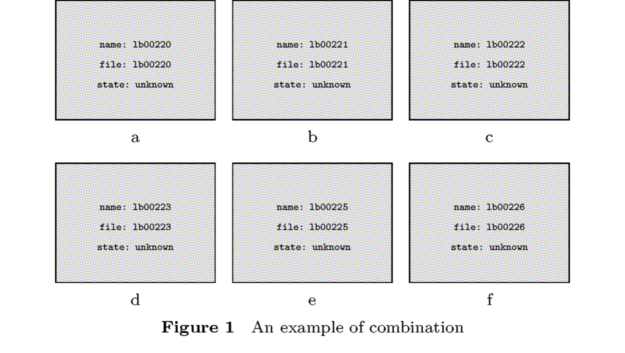Difference between revisions of "Combinations"
(Added a short example for referencing subfigures and explained how the reference-string is build up (just from how I percieved it, I hope it is right).) |
m (Text replacement - "</cmd>" to "}}") |
||
| (7 intermediate revisions by 5 users not shown) | |||
| Line 1: | Line 1: | ||
| − | |||
| − | |||
Combinations are ConTeXt's way to align several pictures (preferrably at same size): | Combinations are ConTeXt's way to align several pictures (preferrably at same size): | ||
| Line 13: | Line 11: | ||
You define, how much figures in columns * rows you'd like to align. | You define, how much figures in columns * rows you'd like to align. | ||
| − | You must provide one "figure something" (e.g. an | + | You must provide one "figure something" (e.g. an {{cmd|externalfigure}}) and a caption for every "cell". |
| − | The sample from the manual: | + | The sample, from the manual, shows how to define a caption for the whole group and use it as float (see [[Floating Objects]]): |
| − | < | + | |
| + | <context source=yes> | ||
\placefigure | \placefigure | ||
| − | [here] % placement | + | [here] % placement option |
[fig:combinations] % reference | [fig:combinations] % reference | ||
{An example of combination} % caption for whole group | {An example of combination} % caption for whole group | ||
| Line 28: | Line 27: | ||
\stopcombination | \stopcombination | ||
} % whole combination in braces of placefigure | } % whole combination in braces of placefigure | ||
| − | </ | + | </context> |
| − | |||
== Setup == | == Setup == | ||
| − | There is | + | There is {{cmd|setupcombinations}} command. |
| − | |||
| − | |||
| − | |||
== Referencing == | == Referencing == | ||
| − | To reference a subfigure you can provide the subfigure's caption as a second parameter to the | + | To reference a subfigure you can provide the subfigure's caption as a second parameter to the {{cmd|in}} command. |
To reference the subfigure with the caption d you would write: | To reference the subfigure with the caption d you would write: | ||
| Line 49: | Line 44: | ||
This would produce something like 'figure 2.4d'. The content of the second parameter simply gets appended to the end of the figure's reference-number, thus the example above would still work even if the caption would be 'd) An awesome subfigure'. | This would produce something like 'figure 2.4d'. The content of the second parameter simply gets appended to the end of the figure's reference-number, thus the example above would still work even if the caption would be 'd) An awesome subfigure'. | ||
| + | |||
| + | |||
| + | [[Category:Graphics]] | ||
Revision as of 13:25, 9 August 2020
Combinations are ConTeXt's way to align several pictures (preferrably at same size):
\startcombination[x*y] {something}{caption} ... ... \stopcombination
means:
You define, how much figures in columns * rows you'd like to align.
You must provide one "figure something" (e.g. an \externalfigure) and a caption for every "cell".
The sample, from the manual, shows how to define a caption for the whole group and use it as float (see Floating Objects):
\placefigure [here] % placement option [fig:combinations] % reference {An example of combination} % caption for whole group { \startcombination[3*2] % 3 columns, 2 rows {\externalfigure[lb00220]} {a} {\externalfigure[lb00221]} {b} % picture and caption for two figures in first row {\externalfigure[lb00222]} {c} {\externalfigure[lb00223]} {d} {\externalfigure[lb00225]} {e} {\externalfigure[lb00226]} {f} \stopcombination } % whole combination in braces of placefigure

Setup
There is \setupcombinations command.
Referencing
To reference a subfigure you can provide the subfigure's caption as a second parameter to the \in command.
To reference the subfigure with the caption d you would write:
\in{figure}{d}[fig:combinations]
This would produce something like 'figure 2.4d'. The content of the second parameter simply gets appended to the end of the figure's reference-number, thus the example above would still work even if the caption would be 'd) An awesome subfigure'.